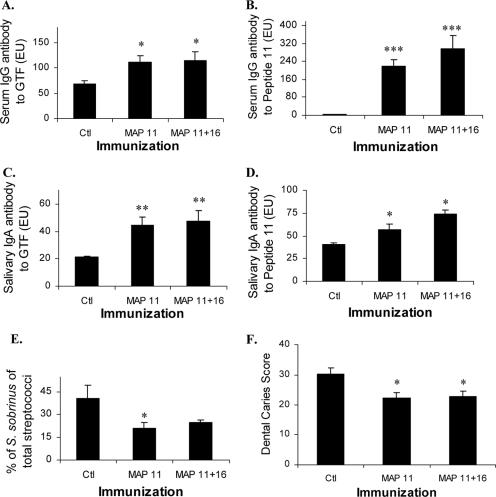FIG. 5.
Immune response to MAP constructs and pathogenesis of dental caries (pathogenesis experiment 2). Rats (8 to 10/group) injected with buffer (control [ctl]) or MAP construct 11 or 11 plus 16 were infected with S. sobrinus for 33 days. (A) Serum IgG antibody to GTF (ELISA units [′EU]) 7 days after booster immunization and before infection is shown as bars depicting group means and standard errors. *, different from control animal group by SNK multiple-comparisons test; statistically significant, P < 0.05. (B) Serum IgG antibody to MAP 11 (EU) after immunization and before infection is shown as bars depicting group means and standard errors. ***, different from control group by SNK multiple-comparisons test; statistically significant, P < 0.05. (C) Saliva harvested after immunization and before infection contained levels of IgA (EU) to GTF, shown as bars depicting group means and standard errors. **, Different from control group by SNK; statistically significant, P < 0.01. (D) Salivary IgA antibody (EU) to MAP 11 as in panel C; *, P < 0.05. (E) Recovery of S. sobrinus expressed as percentage of total streptococcus mean of recoveries on 18 and 30 days after infection, shown as bars and standard errors. *, differences when MAP 11- and 11-plus-16-immunized groups are compared to infected control group by SNK paired one-tailed t test; statistically significant, P < 0.05. (F) Dental caries scores of animals immunized and infected with S. sobrinus for 33 days. Bars show the mean total caries scores, including smooth and sulcal surfaces, and standard errors for 8 to 10 rats/group. *, differences among groups compared by SNK test; statistically significant, P < 0.05.

